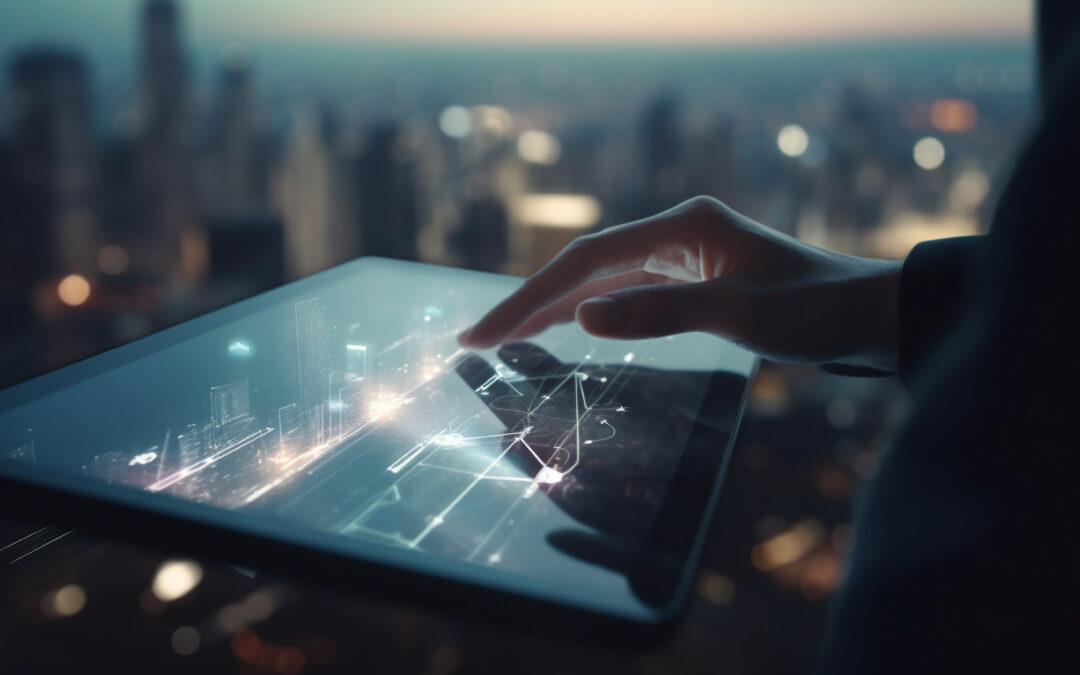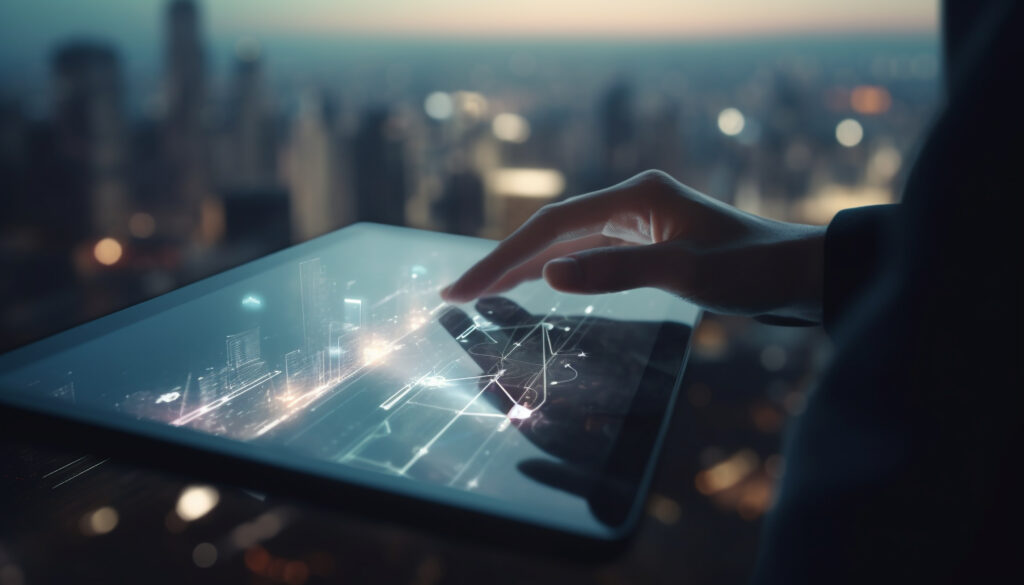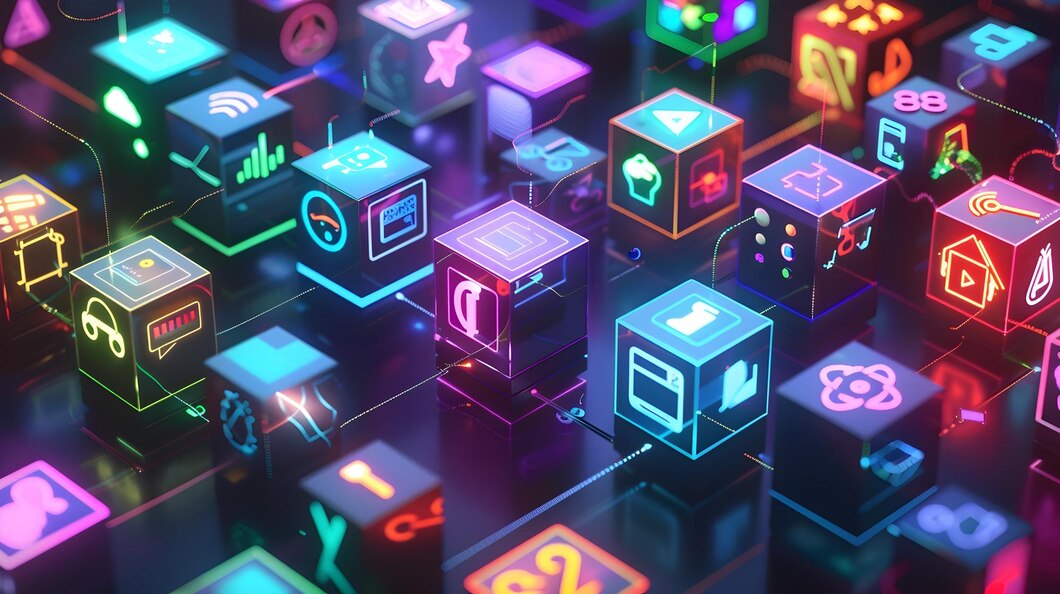
by Huenei IT Services | Sep 11, 2024 | Artificial Intelligence
Serverless: The New Paradigm for Agile and Competitive Companies
Far from being just a trend, serverless architecture is driving a fundamental shift in how businesses approach cost optimization and innovation. This technology is redefining how organizations design, develop, and scale their applications, freeing up valuable resources to focus on their core business.
Alejandra Ochoa, Service Delivery Manager of Huenei, states: “Today, serverless encompasses a complete ecosystem including cloud storage, APIs, and managed databases. This allows teams to focus on writing code that truly adds value to the business, reducing operational overhead and increasing agility. The ability to scale automatically and respond quickly to market changes is essential to stay competitive in an environment where speed and flexibility are crucial.”

Competitive Advantage and ROI
Alejandra Ochoa emphasizes the importance of the serverless cost model: “The accuracy in billing introduced by serverless is revolutionary. By charging only for actual execution time in milliseconds, this ‘pay-per-use’ approach aligns expenses directly with value generated, drastically optimizing TCO (Total Cost of Ownership). This not only impacts operational costs but also transforms financial planning, allowing for greater flexibility and precision in resource allocation.”
This model enables companies to automatically scale during demand spikes without incurring fixed costs during low activity periods, significantly improving their operating margins. This effortless scaling capability is a differentiator in terms of agility, allowing companies to stay competitive in highly dynamic markets.
Challenges and Strategic Considerations
While serverless offers transformative benefits, it’s crucial to address challenges such as cold start latency, potential vendor lock-in, and monitoring complexity. Alejandra Ochoa notes: “These challenges require a strategic approach, particularly regarding the choice of programming languages and platforms.”
For example, cold start times for Java functions in AWS Lambda are nearly three times longer than for Python or Node.js, which is an important factor when choosing a programming language for critical workloads. Similarly, in Google Cloud Functions, cold start times for functions written in Go are considerably longer than for functions in Node.js or Python, which can affect performance in time-sensitive applications.
“Beyond technical challenges,” Ochoa adds, “it’s important to consider the impact on the IT operating model. Transitioning to serverless requires a shift in skills and roles within IT teams. It’s crucial to invest in staff training and process adaptation to maximize the benefits of this technology.”
Synergy with Emerging Technologies
The convergence of serverless with AI and edge computing is opening new frontiers in innovation. This synergy enables real-time data processing and the deployment of more agile and cost-effective AI solutions, accelerating the time-to-market of innovative products. Additionally, the emergence of serverless platforms specialized in frontend development is democratizing full-stack development and enabling faster, more personalized user experiences.
Ochoa provides a more specific perspective on this trend: “In the AI space, we’re seeing how serverless is transforming the deployment of machine learning models. For instance, it’s now possible to deploy natural language processing models that automatically scale based on demand, reducing costs and improving efficiency. Regarding edge computing, serverless is enabling real-time IoT data processing, crucial for applications like monitoring critical infrastructure or managing autonomous vehicle fleets.”
Strategic Impact and Use Cases
Serverless excels in scenarios where agility and scalability are crucial. It facilitates the transformation of monolithic applications into more manageable microservices, improving development speed and market responsiveness. In the realm of IoT and AI, it allows for efficient processing of large data volumes and more agile deployment of machine learning models.
Ochoa shares her perspective on the strategic impact: “In the financial industry, serverless is revolutionizing transaction processing and real-time risk analysis. In healthcare, there’s enormous potential for large-scale medical data analysis, which could accelerate research and improve diagnostics. Furthermore, serverless is redefining how companies approach innovation and time-to-market. The ability to quickly deploy new features without worrying about infrastructure is enabling shorter development cycles and more agile responses to market demands.”
Conclusion
Adopting serverless architectures represents a strategic opportunity for companies seeking to maintain a competitive edge in the digital age. By freeing teams from the complexities of infrastructure management, serverless allows organizations to focus on innovation and delivering real value to their customers.
“For tech leaders, the question is no longer whether to consider serverless but how to implement it strategically,” concludes Ochoa. “This involves not only technical evaluation but also careful consideration of available vendors and technologies, as well as planning for the future evolution of architecture. At Huenei, we are committed to helping our clients navigate this transition and make the most of the opportunities offered by serverless, including its integration with emerging technologies like AI and edge computing.”
 Get in Touch!
Get in Touch!
Francisco Ferrando
Business Development Representative
fferrando@huenei.com

by Huenei IT Services | Sep 10, 2024 | Software development
Optimizing the Agile Cycle with AI: Innovation in Software Development
Artificial Intelligence, is transforming agile practices, offering new tools to tackle complex challenges and enhance efficiency at every stage of software development. Rather than merely following established processes, AI provides advanced capabilities to anticipate obstacles, optimize resources, and ensure quality from the early phases of a project. This innovative approach allows teams to overcome traditional limitations and adapt swiftly to market demands.
At Huenei, we leverage AI technologies that enhance the agile cycle, helping development teams foresee and address issues before they become significant obstacles.

Planning: A Vision Beyond the Sprint
Traditional agile planning, based on team experience and historical data, faces the challenge of forecasting and prioritizing effectively in a high-uncertainty environment. AI, with its predictive analysis capabilities, enables teams to anticipate problems and adjust priorities more precisely. It’s as if each sprint planning session had an additional expert who has already evaluated the code and knows where issues might arise, facilitating more accurate and business-aligned planning.
By integrating tools like GitHub Copilot and machine learning algorithms, teams can analyze code usage and behavior patterns to anticipate scalability and performance issues. If your team isn’t yet maximizing performance in application modernization, Huenei could be the technology partner you need, with dedicated agile teams and developers selected for your project.
Development: Team Coding with AI
During the development phase, one major issue is the potential for introducing errors or adopting suboptimal design patterns, which can lead to costly rework. Here, AI acts as a proactive assistant, reviewing each line of code in real-time and suggesting improvements that enhance the software’s quality and security. Tools like GitHub Copilot, powered by the GPT language model, suggest code snippets and design solutions that boost team efficiency and ensure adherence to best practices from the start.
In agile and dynamic development environments, advanced technologies are employed to ensure systems are prepared to scale without compromising security. At Huenei, we help our clients maximize the value of these technologies to achieve optimal performance in their projects.
Quality Control: Intelligent Real-Time Testing
The quality control phase faces the challenge of ensuring that software functions correctly under all possible conditions—a process that can be lengthy and prone to errors. AI addresses this issue by automating and enhancing testing, identifying edge cases and potential errors that human testers might overlook. Platforms that automate the generation and execution of test cases ensure that each build is rigorously evaluated before deployment.
For example, in a financial application, unusual traffic patterns or race conditions in concurrent transactions can be simulated, identifying vulnerabilities that might be missed in manual tests. This approach not only improves software quality but also reduces the time required for thorough testing, accelerating delivery time without sacrificing reliability.
Documentation: Keeping Pace Without Losing Detail
Documentation, which often feels like a secondary task amidst Agile’s speed, now has powerful allies in AI. Tools like GPT-4, ChatGPT, and GitHub Copilot can automate the creation of technical documentation, keeping everything updated without the team losing momentum.
For example, AI automation can generate technical documentation directly from the code, saving time and improving accuracy. Additionally, these tools facilitate the creation of multilingual and customized documentation for different users, keeping everything up-to-date in real-time.
Conclusion: Redefining Software Development with AI
Integrating AI into the agile cycle not only optimizes processes but also redefines how development teams tackle challenges, enabling them to meet sprint objectives and adapt to the ever-evolving business needs. At Huenei, we harness this synergy between Agile and AI to provide a clear competitive advantage. Contact us to explore how we can help your company maximize these benefits and tackle the challenges of digital transformation.
 Get in Touch!
Get in Touch!
Francisco Ferrando
Business Development Representative
fferrando@huenei.com

by Huenei IT Services | Jun 4, 2024 | Artificial Intelligence
Generative AI is no longer in the experiment stage. Chief Information Officers (CIOs) are now looking to ramp up these solutions and gain a real edge in the market. However many companies are hitting roadblocks that prevent them from maximizing the potential of
Generative AI.
While the challenges organizations face often fall into common categories, the solutions must be tailored to each company’s unique needs.

Choosing the Right Path
The first step is deciding how your company will integrate these new tools. There are three main options: pre-built tools, custom models with your own data, and building your own large language models (LLMs).
Here are some key factors to consider when making this choice:
- Resources and budget: Pre-built tools are the most cost-effective option but offer less control. Integrating models with your data requires investment in infrastructure and talent. Building LLMs from scratch is the most expensive option, requiring significant resources and cutting-edge expertise.
- Specific needs and use cases: If you only need Generative AI for basic tasks, pre-built tools might suffice. However, if you require highly specialized AI for your core products or services, building custom solutions will provide a greater long-term advantage.
- Data ownership and regulations: In some industries, regulations or data privacy concerns might necessitate integrating models with your data or building solutions in-house.
- Long-term AI strategy: If AI is simply another tool in your toolbox, pre-built solutions might work. But to gain a competitive advantage through AI, you’ll need to develop unique in-house capabilities.
For example, FinanceCorp initially used pre-built Generative AI tools for tasks like writing and summarizing reports. However, these tools proved inadequate for complex financial tasks like risk analysis and contract reviews. To achieve the performance they needed, they had to switch to a custom model solution with their own data.
Taming the Generative AI Beast
One key lesson learned from pilot projects is the importance of avoiding a sprawl of platforms and tools. A recent McKinsey survey found that “too many platforms” was a major obstacle for companies trying to implement Generative AI at scale. The more complex the infrastructure, the higher the cost and difficulty of managing large-scale deployments. To achieve scale, companies need a manageable set of tools and infrastructure.
One solution is to establish a centralized, single-source enterprise Generative AI platform. While this requires initial standardization efforts, it can significantly reduce operational complexity, ongoing maintenance costs, and associated risks in the long run. It also facilitates consistent and scalable deployment of Generative AI across the organization.
A hybrid approach that combines internal and external expertise might be the most effective strategy. Partnering with a leading technology provider can provide a solid foundation for a robust Generative AI platform. However, you’ll also need to build an internal team with expertise in data science, AI engineering, and other relevant fields. This team can then customize, expand, and manage the platform to meet your specific business needs.
For instance, HSBC, after piloting solutions with seven different Generative AI vendors, faced challenges with high maintenance costs, governance issues, and integration complexities. They decided to consolidate everything on Microsoft’s platform and standardize APIs, data flows, monitoring, and other aspects. This approach helped them reduce their AI operating costs by over 60%.
Conquering the Learning Curve
Finally, there’s the ever-present learning curve. CIOs understand the technical skills needed for Generative AI, such as model fine-tuning, vector database management, and application and context engineering. However, acquiring this knowledge can be a daunting process. Building all the specialized skills in-house can be extremely slow and challenging. Even with an accelerated learning curve, it could take months for an internal team to reach the required level of expertise.
Retail giant GiganteCorp allocated a significant budget of $15 million to assemble an elite team of 50 data scientists and engineers with experience in fine-tuning cutting-edge language models, application engineering, and vector knowledge bases. However, due to the high demand for these specialists in the market, they were only able to fill 40% of the positions after a year.
The lack of prior experience and the need to master new technologies can make implementing Generative AI seem like a formidable task. However, by partnering with an experienced technology partner, companies can overcome these challenges and unlock the full potential of Generative AI to transform their operations.
After several failed attempts to develop their own Generative AI models, the legal firm BigLaw partnered with experts from Anthropic. Their guidance in best practices, benchmarking, iterative refinement, and thorough testing enabled their contract review system to achieve over 95% accuracy in less than six months, a 30% improvement over previous attempts.
A specialized Generative AI partner can and should continue to provide ongoing consulting and support services, even after initial capabilities have been implemented within the organization. Inevitably, challenges, bottlenecks, or highly specific requirements will arise as Generative AI usage is deployed and scaled. Accessing the deep expertise of these consultants can be key to resolving them effectively.
The Generative AI models deployed by the fintech company Novo initially yielded excellent results in tasks such as fraud detection and customer support. However, after eight months, performance degradations began to be observed as data patterns shifted. They had to implement continuous data retraining and recycling pipelines to maintain accuracy levels.
In conclusion, Generative AI systems are not one-time projects; they require continuous refinement and updating. Adopting a mindset of constant testing, learning, and improvement based on feedback and empirical data is crucial for maximizing the long-term value of Generative AI.
 Get in Touch!
Get in Touch!
Francisco Ferrando
Business Development Representative
fferrando@huenei.com

by Huenei IT Services | Jun 4, 2024 | Infra, Software development
Imagine the frustration of a holiday shopping surge crashing your e-commerce platform. Legacy monolithic applications, while familiar, often struggle with such unpredictable spikes. Enter microservices architecture, a paradigm shift promising agility, scalability, and maintainability for modern software. But is it the right choice for you? Let’s explore the power and considerations of microservices with IT veteran Richard Diaz Pompa, Tech Manager at Huenei.

The Power of Microservices
Microservices architecture fundamentally reimagines application development. Instead of a monolithic codebase, microservices decompose the application into a collection of independent, self-contained services. Each service owns a specific business capability and interacts with others through well-defined APIs. This modular approach unlocks several key advantages.
“Imagine a monolithic application as a monolithic server. If a single functionality spikes in usage, the entire server needs to be scaled up, impacting everything else,” explains Richard; “with microservices, your application is like a collection of virtual machines. If a particular service sees a surge in activity, only that specific service needs to be scaled up.” This targeted approach optimizes resource allocation and ensures smooth performance for the entire application, even under fluctuating loads.
Another key advantage lies in improved maintainability. Traditionally, monolithic applications can be likened to complex engines. Fixing a single component often requires a deep understanding of the entire intricate system. Microservices, on the other hand, are like smaller, self-contained engines. Developers can focus on improving a specific service without needing to delve into the complexities of the entire application. This modularity not only simplifies development but also streamlines troubleshooting and debugging issues.
Conquering the Challenges: Strategies for Smooth Implementation
“While the benefits of microservices are undeniable, their implementation introduces complexities that require careful consideration,” Richard remarks, “increased service communication overhead, managing a distributed system, and ensuring data consistency across services are common hurdles that organizations must overcome.”
Organizations can leverage API gateways, service discovery mechanisms, and event-driven architectures to mitigate communication challenges. API gateways act as single-entry points for all microservices, simplifying external client access and handling tasks like authentication and authorization. Service discovery tools like Zookeeper or Consul allow services to dynamically register and find each other, reducing manual configuration headaches. Event-driven architectures, where services communicate by publishing and subscribing to events, promote loose coupling and simplify communication patterns.
Leveraging containerization technologies like Docker packages and deploys microservices in standardized, lightweight environments. This simplifies deployment and management compared to traditional methods. Microservices orchestration tools like Kubernetes can further automate deployment, scaling, and lifecycle management of microservices, reducing the operational burden on IT teams.
Furthermore, ensuring consistent data formats and interactions across services is crucial. Well-defined API contracts promote loose coupling and simplify data exchange between services. The CQRS (Command Query Responsibility Segregation) pattern separates read and write operations across different services, improving data consistency and scalability for specific use cases. In some scenarios, eventual consistency, where data eventually becomes consistent across services, might be an acceptable trade-off for improved performance and scalability.
“Successful microservices adoption requires a holistic approach that considers not only technical implementation but also strategic alignment with business objectives, risk management, and long-term digital transformation roadmaps,” cautions Richard. “Partnering with experienced microservices professionals or consulting firms can provide valuable guidance and expertise in industry best practices, emerging technologies, and proven methodologies.”
The Final Verdict: A Well-Considered Choice
“IT leaders must carefully evaluate their organization’s needs, resources, and readiness for adopting a microservices architecture.” Richard highlights “while the benefits are substantial, the increased complexity and operational overhead might not be suitable for every project. A thorough assessment of the potential advantages and challenges, coupled with a well-defined implementation strategy, is essential for successful adoption.”
As enterprises navigate the complexities of the digital landscape, microservices architecture presents a compelling path forward. “By carefully considering their unique requirements and seeking guidance from experienced professionals, CIOs can make informed decisions about whether and how to leverage this architectural approach. This ensures their software systems remain not only scalable and maintainable but also agile enough to thrive in the ever-evolving digital world,” he concludes.
 Get in Touch!
Get in Touch!
Francisco Ferrando
Business Development Representative
fferrando@huenei.com

by Huenei IT Services | Jun 3, 2024 | Artificial Intelligence, UX & UI Design
Progressive Web Apps (PWAs) are revolutionizing the way businesses deliver web experiences. By merging the best aspects of traditional websites and native mobile apps, PWAs offer a seamless, app-like user experience accessible through any web browser.

The best of two worlds
PWAs work for every user, regardless of the browser they’re using. They provide an enhanced experience for modern browsers that support the latest web standards, while still functioning as a traditional website on older browsers. Can work offline or with poor network connectivity by leveraging service workers, a script that acts as a client-side proxy, and caching app resources and data for offline use.
Also, they are searchable and discoverable through search engines, just like regular websites, providing a wider reach compared to native apps in app stores.
Progressive Web Apps eliminate the need to develop and maintain separate native apps for different platforms (iOS, Android, etc.). A single codebase can target multiple platforms, reducing development and maintenance costs. Unlike native apps, PWAs do not require installation from app stores, making them accessible to anyone with a web browser. They can be updated seamlessly without user intervention, ensuring users always have access to the latest version. This eliminates the need for manual app updates, reducing overhead and ensuring a consistent experience across users.
PWAs can leverage existing web infrastructure and APIs, making it easier to integrate with existing systems and processes within the organization. This can reduce the need for extensive refactoring or migration efforts. Additionally, they can be built using a modular architecture, allowing different components or features to be developed and deployed independently. This can aid in scalability and enable large businesses to incrementally roll out new features or updates.
Overall, PWAs offer businesses a cost-effective, scalable, and user-friendly solution for delivering engaging web experiences across multiple platforms, while leveraging existing web infrastructure and technologies. This can lead to improved user engagement, reduced development and maintenance costs, and better compliance with security and privacy standards.
The AI obsession
Progressive Web Apps can integrate AI technology to provide enhanced functionality and user experiences.
These new applications can leverage NLP to enable voice commands, chatbots, or virtual assistants. This allows users to interact with the app using natural language, enhancing accessibility, and providing a more intuitive user experience.
Also, machine learning algorithms can be integrated into PWAs for various purposes, such as:
- Personalization: Analyzing user behavior and preferences to provide personalized recommendations, content, or experiences.
- Predictive analytics: Predicting user actions, needs, or preferences based on historical data and patterns.
- Image/object recognition: Identifying objects, faces, or features in images or videos within the PWA.
AI can be used to assist users in filling out forms by automatically populating fields based on user inputs or previous data, reducing friction and improving the user experience. Can also analyze user behavior, preferences, and context to deliver highly relevant and personalized notifications at the right time, improving engagement with the PWA.
With the help of technologies like TensorFlow.js, AI models can be integrated into PWAs and run directly in the user’s browser, enabling intelligent features even when the device is offline.
What about data privacy?
Developing an AI-powered Progressive Web App (PWA) that meets stringent privacy standards and complies with certifications like ISO 27001 demands a comprehensive approach. Companies must embrace a “Privacy by Design” mindset from the outset, weaving data protection principles into every phase of development.
Data minimization is key, collecting only essential user information for the AI functionality while providing transparent communication about data usage. Robust data handling measures, including encryption, secure protocols, and fortified storage, safeguard user privacy.
Empowering users with clear consent mechanisms and control over their data fosters trust. Rigorous auditing, logging, and periodic risk assessments maintain accountability and enable swift identification of potential issues.
Adhering to privacy regulations like GDPR and implementing secure AI model training processes further reinforce compliance. Ethical AI principles, such as transparency, fairness, and explainability, underpin the system’s responsible operation.
By integrating privacy and security measures holistically throughout the lifecycle, companies can deliver innovative AI-powered PWAs that prioritize user trust and data protection, setting new standards for responsible technology.
Too good to be true?
Considering the breadth of skills required, it may be challenging for a single team or organization to possess all the necessary expertise. In such cases, finding an experienced partner or consulting firm that specializes in AI-powered development can be a viable option.
An experienced partner can provide:
- Proven expertise and a skilled team with the required technical capabilities
- Established best practices, methodologies, and tools for PWA and AI development
- Experience in navigating regulatory and compliance requirements
- Access to specialized resources and infrastructure
- Ability to scale resources as needed and provide ongoing support and maintenance
PWAs equipped with AI capabilities represent a powerful tool for businesses seeking to deliver a superior user experience, reduce costs, and gain a competitive edge. By partnering with an experienced software development firm, you can leverage this technology while ensuring the highest security and privacy standards are met.
 Get in Touch!
Get in Touch!
Isabel Rivas
Business Development Representative
irivas@huenei.com


 Get in Touch!
Get in Touch!




 Get in Touch!
Get in Touch!



 Get in Touch!
Get in Touch!